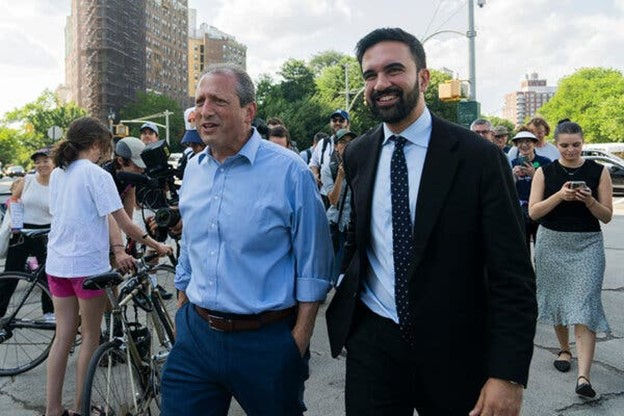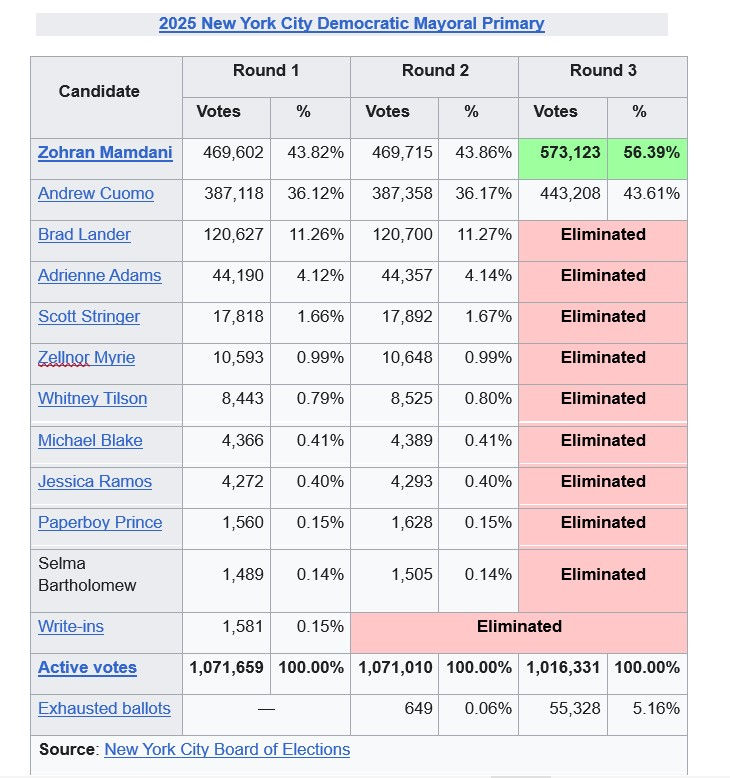What New York City’s Mayoral Primary Reveals about Ranked Choice Voting
- Jul 21
- 5 min read
Updated: Sep 4
It’s not what it appears


By Silence Dogood, Guest Columnist
July 21, 2025
The late June victory of socialist and Shia Muslim Zohran Mamdani in the city’s Democratic primary has a lot of political observers saying ranked choice voting (RCV) was a big success and crucial to pushing the candidate across the finish line to win. However, a deeper dive into the numbers and processes reveals some contrary information. The basis for this analysis is a New York Times (NYT) article discussing the Mamdani win.
In the chart below, the first thing to note is Mamdani would have won the Democrat nomination in Round 1 of the tabulations under conventional “one person, one vote” voting process. He was the top vote-getter with 446,163 ballots cast in his favor vs. Andrew Cuomo’s 374,818 votes — by any measure, a substantial win. But he didn’t get to 50% + 1 of the vote which is what RCV requires to declare a winner.

Round 2 of the tabulations had very little impact. A 50% + 1 majority still had not been achieved. By the end of Round 3, only Cuomo and Mamdani remained, and the tabulations gave Mamdani the victory, a “manufactured” RCV majority, not a real majority.
The chart also shows almost 56,000 (649 + 55,328) votes were discarded in the final total. They’re called “exhausted” or “inactive” ballots. While the number of 2025 discarded ballots was an improvement over 2021, the July 1 NYT article said it was driven mainly by the size of the victory. Working with preliminary election returns, not final results, the NYT wrote:
There were 52,919 exhausted ballots this year, compared with 140,202 in the 2021 mayoral primary. That means roughly 5% of ballots were inactive this year out of more than one million cast. In 2021, nearly 15% of ballots were inactive.
Jake Rubinstein, a senior manager at a polling firm, said the small number of inactive ballots this year was more “evidence that this was really a two-person race and 2021 wasn’t [emphasis added].
The article also pointed out there was a lot of “gamesmanship” in this primary. RCV talks about bringing campaigns together and appealing to the majority. However, RCV shows an organized energetic group can push a more radical candidate to a win. Everyone agrees that Mamdani is not a centrist candidate.
All the campaigns tried to game the system, which allows voters to rank up to five candidates in order of preference. Organizations made group endorsements; campaigns told voters to avoid ranking specific candidates; and several contenders made cross-endorsement deals.
All these “deals” make apparent various groups were coalescing to vote AGAINST a candidate and not FOR a candidate. Other campaigns like Alaska U.S. Senate and Representative races in 2022 did the same thing. This is not what RCV has promised.
Mr. Lander and Mr. Mamdani filmed a commercial together, and Mr. Lander, a Reform Jew, likely helped Mr. Mamdani deflect some of the heavy criticism he was receiving from pro-Israel groups. At the end of the campaign, Mr. Lander spent $340,000 on ads and robocalls attacking Mr. Cuomo.
“I did not want to wake up the day after Election Day to find Andrew Cuomo had won and I had not done every single thing I possibly could,” Mr. Lander said in an interview.
When you have a manufactured majority, all the lower candidate parties and their platforms end up getting rolled up into the winner and runner-up. Minor parties have very specific issues they care passionately about, like the Green Party and the environment. RCV merges them into the two candidates’ totals and platforms. What impact that has on minor party causes in the future will have to be seen. Will they tend to be softened as the major party incorporates them within their other causes? Time will tell.
When you cast a vote in the current “one person, one vote” system, your vote stands out for what you care about in the final election result even if your candidate did not win.
RCV fundamentally transforms the “one person, one vote” process the United States has employed throughout its history. It creates gamesmanship and backroom deals. and doesn’t drive parties and candidates together. Its claims of “kinder and gentler” campaigns designed to reach out to a majority of voters have proven untrue. What we have seen so far in RCV elections is voters — far from being put in a melting pot — are forced to sacrifice their platforms and causes and are instead becoming a gumbo of temporary coalitions.
Many votes are discarded to manufacture the so-called “majority.” From a practical standpoint, only two small-population states — Alaska and Maine — have RCV. Do Michigan voters really want to experiment with their large population swing state?
These reasons and more account for why more than 15 states have banned RCV, including Missouri with a recent, citizen-approved constitutional amendment.
For those preferring a 50% + 1 majority, a workable solution already exists within our current system of voting. It is called a run-off election.
When the top two vote-getters go head-to-head, voters can decide whom they prefer to win, and they have an opportunity to change their minds and vote for one of two candidates whom they really want, not settling for unpalatable second or third choice.
RCV is a complex solution to a problem that has a simple and cleaner answer. To allow gamesmanship by organized groups and obscure counting and auditing processes, to pay more for elections with slower election results, and then to settle for second- or third-rate candidates is not the solution for Michigan. When the facts are laid out, the answer is no to RCV in Michigan.
Join us Thursday, July 24,
at 12 PM for the weekly
Coalition Task Force Meeting

Use the Registration link above to
attend this meeting. It changes weekly.
After registering, you'll receive an email with details on how to join the meeting.

If you have a news tip related to federal, state, or local elections, contact us HERE.

Mark your calendars to attend Election Integrity Network's outstanding National Working Group Meetings. Consider also serving as liaison to report to the Task Force Coalition on our Thursday News@Noon meetings.
View and download special publications from EIN: US Citizen's Elections Bill Of Rights, Ranked Choice Voting presentation.
The views and opinions expressed in this commentary are those of the author and do not reflect the official position of the Michigan Fair Elections Institute. Content, links or images embedded within the article, may have been generated by artificial intelligence.
















Comments